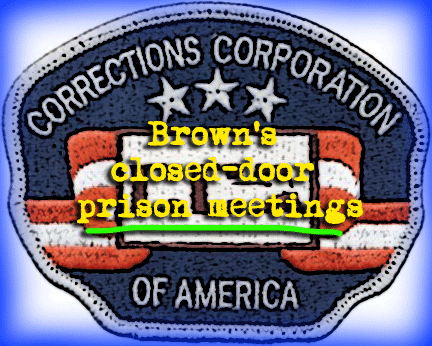ACLU SAYS PRISON PLANNING MEETINGS SHOULD BE OPEN TO PUBLIC
Quite a number of people are unhappy with the secrecy that Gov. Jerry Brown is operating under regarding state’s efforts to lower the prison population by 9400 inmates, including his new deal with the for-profit prison company Corrections Corporation of America.
The ACLU has sent a letter to Gov. Jerry Brown asking him to grant the public access to his currently closed-door meetings about how the state will comply with the federal court order. (Go here for WLA’s Sunday post on Gov. Brown’s costly proposal to lease for-profit prisons to house inmates.)
The LA Times Paige St. John has more on the issue. Here’s a clip:
Details of the plans are being hashed out away from public view — even Assembly Budget Committee Chairwoman Nancy Skinner (D-Berkeley) said last week that she was in the dark on the matter.
[Updated, 11:28 a.m. PDT Aug. 26: Brown’s office would not respond to questions about the lack of public discussion. Instead, said spokesman Jim Evans, “the administration is working on a range of options with the Legislature to comply [with] the court order while maintaining public safety.”]
“It is crucial this policy receive a complete and thorough review giving constituents and stakeholders a chance to express their opinions,” ACLU of California officials Francisco Lobaco and Kimberly Horiuchi wrote in a joint letter delivered to Brown late Friday. They called for public legislative hearings.
They argued that Brown is about to make an “ill-advised expenditure of critical tax dollars” to fix problems present for a long time.
CALIFORNIA PROBATION DEPTS. CREATE INNOVATIVE PROGRAMS TO KEEP THOSE SUPERVISED UNDER REALIGNMENT FROM RE-OFFENDING
Probation departments across California are developing new re-entry programs and resources—from “motivational interviewing,” to “re-entry pods,” to day-reporting centers—offered to offenders under county supervision through realignment. Although it is too soon to tell which strategies are effectively combatting recidivism, it is heartening to see more being done to aid inmates with the transition back into their communities.
Gillian Flaccus of the Associated Press has the story. Here’s a clip:
When Yen Ly was released from behind bars this spring, she assumed it wouldn’t be long before she began committing credit card fraud again to keep up with bills while feeding a devastating meth habit.
This time, however, was different. Five months later, the 29-year-old single mother who had been convicted twice for identity theft is a fulltime beauty school student, performs community service and has consistently tested clean for drugs.
Ly also is on the leadership committee of a special center where low-level ex-cons can take classes, learn parenting skills, get job training and complete drug and alcohol counseling — all in the same place. She said the program gave her structure and confidence and helped her grow as a parent.
“I feel as if they’re giving me a second chance and I’m not going to waste it,” Ly said. “I’ve gone this far and I don’t want to go back.”
Ly is one of thousands of lower-level felons in California being supervised by local authorities instead of state parole officers under a recent law that overhauled the state’s criminal justice system. Under the so-called realignment law, counties — and not the state — now bear the responsibility for housing inmates convicted of most non-serious, non-sexual and non-violent felonies and for watching them after their release.
[SNIP]
As a result, counties have been developing new strategies to keep felons from re-offending, which would now land them in already-overcrowded county lock-ups instead of state prison.
In less than two years, county probation departments more accustomed to handcuffs than hand-holding have entered a new world in which buzzwords such as “motivational interviewing” and “cognitive-behavioral therapy” are routine, and role-playing and journal-writing for ex-cons are an accepted part of doing business.
Probation departments in many counties, including Orange, have used the state funding that accompanied realignment to set up day-reporting centers where offenders can get everything from job training to parenting tips to help getting a new driver’s license. Others have created networks between county mental health departments, law enforcement, homeless shelters and local substance abuse treatment programs to respond to inmates’ needs.
WWLA? SHOW ON FOSTER CARE HOUSING SHORTAGE IN LOS ANGELES
Monday night, KCRW’s Warren Olney, on his show Which Way, LA? hosted a discussion with the LA Times’ Garrett Therolf, the director of the Department of Children and Family Services Philip Browning, and Andrew Bridge of the Child Welfare Initiative in response to Therolf’s Sunday report on California’s critical lack of sufficient beds for foster care children. (For WLA’s previous post, go here.) Here’s a very small clip (but do go listen to the whole thing):
Olney: Garrett reports that it sometimes takes a hundred calls from a social worker to place a child. Mr. Browning, why does it take so many?
Browning: Well, one of the problems is that we don’t have as many foster parents as we need. About five years ago, we had 2000 state-licensed parents. Today, we have 540. Five years ago, we had about 4500 homes through the agency concept, this year—this month—we have less than 3000. So, we’ve had almost a 50% drop in our capacity…
SHERIFF’S CANDIDATE UPDATES
Recommended listening: KABC radio’s Doug McIntyre interviewed LA County Sheriff candidate Patrick Gomez on his show Monday morning. (Fast-forward to about the 6:50 minute-mark for Gomez’s interview.)


It’s long past time to change the California state flag to accurately represent current reality. The brown bear needs to disappear – there is no respect left in Sacramento for him. The new flag should feature iconography that represents a state penitentiary and an Indian casino. Now that’s the real California Republic!